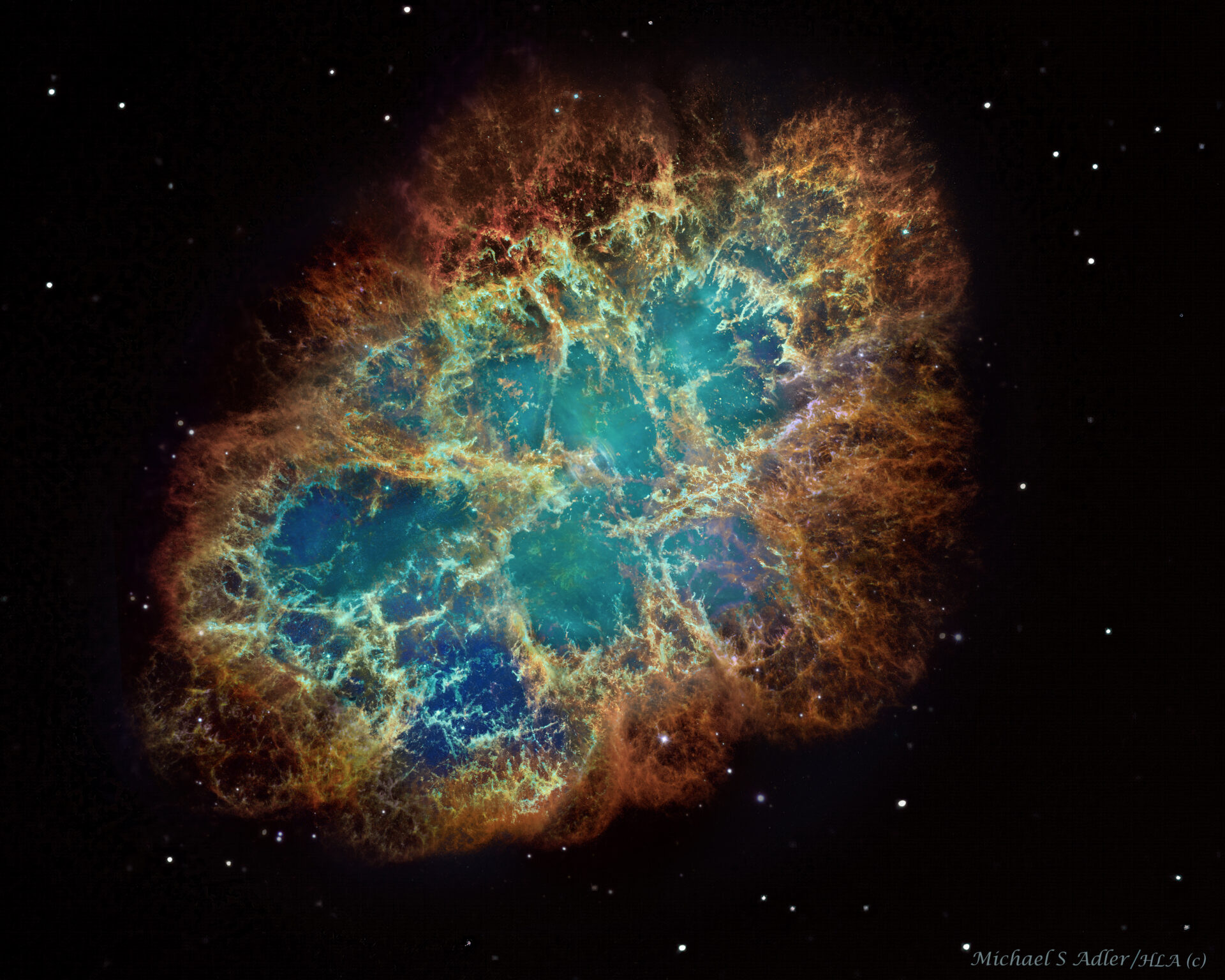Optics: Hubble,HST, 20″ Planewave CDK20
Mount: Software Bisque Paramount MEII
Camera:WFC2, FLI Pl16803
Filters: Hubble 502n, 631n, 673n,Astrodon 3nm narrowband Ha, Oiii, Sii
Dates/Times: 1999,2000, September, 2020, 2018,2016
Location: HST & Adler Earth and Sky Observatory, Jackson WY
Exposure Details: Hubble exposures were 40 minutes per filter and 16 hours overall, CDK20, Ha=43x20min,2:2, Oiii,Sii, 34x20min, 4:4 total 110 images, 37 hours
Acquisition: MaxIm DL TheSkyX, SBIG STi guiding
Processing: MaxIm DL, BlurX, Photoshop 2024, 502n(Red), 673n(Green),631n(Blue)
Crab Nebula, Messier 1,(HST, CDK20)
Original price was: $65.00.$52.50Current price is: $52.50.
Crab Nebula,Messier 1, The Crab Nebula is the remnant of the of a star 6-10x the size of the Sun and is the result of a supernova seen in 1054 AD. The Crab Nebula spans about 13 light years and is about 6 arc seconds in size in the sky or about 1/5 of the size of the full moon. It is 6500 light years distant. In the nebula’s center lies a neutron star: a star as massive as the Sun but is only 30 kilometers in size. Supernovae from large dying stars 6-10X the size of the Sun either result in a neutron star or a black hole. In this case the remnant is a neutron star and can be located in the image as the dimmer of two small stars near the center of the image. Curved shaped shockwaves are located on both sides of the neutron star. The neutron star rotates about 30 times each second with extreme precision similiar to an atomic clock and emits a beam of energy along its poles ranging from radio frequencies to gamma rays. At X-ray wavelengths (above 1 keV), it is one of the brightest, continuously emitting sources in the sky. At optical wavelengths it is quite dim but is 1000X brighter than any other known neutron star in the sky and as such is visible in this image. Such a neutron star is referred to as a Pulsar. The beam is the result of the rotational energy of the neutron star, which generates an electrical field from the movement of its very strong magnetic field, resulting in the acceleration of protons and electrons on the star surface and the creation of an electromagnetic beam emanating from the poles of the magnetic field. It is described as a “lighthouse” emitting a regular pulsating beam of light. The nebula surrounding the neutron star was created by the remnant gas and dust from the star explosion. It is expanding at a rate of 1500km/sec, 0.5% of the speed of light.
The core of the image comes from the Hubble Space telescope and the background stars came from the Adler 20″ Planewave telescope. The raw data from the Hubble HST was taken from the MAST(Mikulski Archive of Space Telescopes) website and consists of 24 black and white images from 3 narrowband filters comprising 8 separate images. Each exposure was about 40 minutes with a total exposure time of 16 hours. The combined image was very difficult to make. First, the 24 images needed to be “non linearly stretched” to bring out the detail in the darkest and brightest portion of the images. They were then combined into 8 false color images from the narrowband filters Hubble used. Red came from the Oiii filter(502nm), Green from the Sii filter(673nm), and Blue from the Oi filter(631nm). Combining the 8 color images into a single image was difficult because the color and quality of the images were different. The The detail of the pulsar was enhanced with a separate Hubble image although the semi circular shockwaves were visible in the un enhanced image. Finally the Hubble image had to be overlayed on a separate image taken by my 20″ Planewave telescope since the Hubble image only contained the core image with a very irregular border. The un compressed tiff image was 11436 x 9150 pixels and 306 megabytes.


